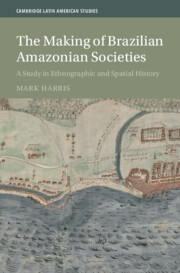Refine search
Actions for selected content:
321 results
Chapter 2 - Perceptual Reference and Discrimination
-
- Book:
- Kant and the Power of Perception
- Published online:
- 27 November 2025
- Print publication:
- 11 December 2025, pp 51-89
-
- Chapter
- Export citation
Chapter 6 - Manifolds of Intuition and Mereological Organization
-
- Book:
- Kant and the Power of Perception
- Published online:
- 27 November 2025
- Print publication:
- 11 December 2025, pp 191-219
-
- Chapter
- Export citation
3 - Coming Out of the Forests?
-
- Book:
- The Making of Brazilian Amazonian Societies
- Published online:
- 14 November 2025
- Print publication:
- 20 November 2025, pp 103-132
-
- Chapter
- Export citation

The Making of Brazilian Amazonian Societies
- A Study in Ethnographic and Spatial History
-
- Published online:
- 14 November 2025
- Print publication:
- 20 November 2025
5 - Imam-Hatip Schools
- from Part II - The Grassroots Mobilization
-
- Book:
- Pious Politics
- Published online:
- 21 October 2025
- Print publication:
- 30 October 2025, pp 127-166
-
- Chapter
- Export citation
Built Space, Written Space: Baroque Spatialities between Architecture and Text in Lucan, Statius, and the Palaces of Imperial Rome
-
- Journal:
- Antichthon , First View
- Published online by Cambridge University Press:
- 27 October 2025, pp. 1-29
-
- Article
- Export citation
6 - Seeing the Past
-
-
- Book:
- Relief in Greek, Roman, and Late Antique Art
- Published online:
- 11 October 2025
- Print publication:
- 25 September 2025, pp 199-231
-
- Chapter
- Export citation
Chapter 6 - Visual Space
-
- Book:
- The Neural Structure of Consciousness
- Published online:
- 27 July 2025
- Print publication:
- 18 September 2025, pp 172-201
-
- Chapter
- Export citation
Introduction
-
- Book:
- The Nature of the Ottoman City
- Published online:
- 28 August 2025
- Print publication:
- 11 September 2025, pp 1-26
-
- Chapter
-
- You have access
- HTML
- Export citation
The Stories of “Plants for Space” Exploring Intentionally Positive and Sustainable Futures
-
- Journal:
- Australian Journal of Environmental Education / Volume 41 / Issue 3 / July 2025
- Published online by Cambridge University Press:
- 09 September 2025, pp. 565-584
-
- Article
-
- You have access
- Open access
- HTML
- Export citation
Preface
-
- Book:
- Satellite Remote Sensing for Water Management
- Published online:
- 10 October 2025
- Print publication:
- 04 September 2025, pp xiii-xv
-
- Chapter
- Export citation
Chapter 8 - The Peloponnesian War and the Changing Shape of the World
-
-
- Book:
- Reassessing the Peloponnesian War
- Published online:
- 21 August 2025
- Print publication:
- 04 September 2025, pp 225-248
-
- Chapter
- Export citation
Beyond production: Following nomadic space in IR
-
- Journal:
- Review of International Studies , First View
- Published online by Cambridge University Press:
- 01 September 2025, pp. 1-19
-
- Article
- Export citation
Chapter 4 - The Geographies of British Postmodern Fiction
-
-
- Book:
- The Cambridge Companion to British Postmodern Fiction
- Published online:
- 07 August 2025
- Print publication:
- 21 August 2025, pp 66-81
-
- Chapter
- Export citation
11 - Breaking New Ground: Novel Approaches to Understanding Catatonia and the Brain–Mind Relationship
-
- Book:
- Catatonia
- Published online:
- 26 July 2025
- Print publication:
- 14 August 2025, pp 144-154
-
- Chapter
- Export citation
Chapter 5 - Learning in drama
- from Part 2 - What: the arts learning areas
-
- Book:
- Teaching the Arts
- Published online:
- 28 July 2025
- Print publication:
- 06 August 2025, pp 130-171
-
- Chapter
- Export citation
1 - Frontiers
- from Part I - Practices of Space
-
- Book:
- Fractured Pasts in Lake Kivu’s Borderlands
- Published online:
- 17 July 2025
- Print publication:
- 31 July 2025, pp 51-84
-
- Chapter
- Export citation

Fractured Pasts in Lake Kivu’s Borderlands
- Conflicts, Connections and Mobility in Central Africa
-
- Published online:
- 17 July 2025
- Print publication:
- 31 July 2025
The Future of (Environmental) History: A Roundtable Discussion
- Part of
-
- Journal:
- Transactions of the Royal Historical Society / Volume 3 / December 2025
- Published online by Cambridge University Press:
- 17 July 2025, pp. 427-447
- Print publication:
- December 2025
-
- Article
-
- You have access
- Open access
- HTML
- Export citation
8 - Spatio-temporal Analysis
-
- Book:
- Spatial Analysis
- Published online:
- 19 June 2025
- Print publication:
- 03 July 2025, pp 227-257
-
- Chapter
- Export citation
